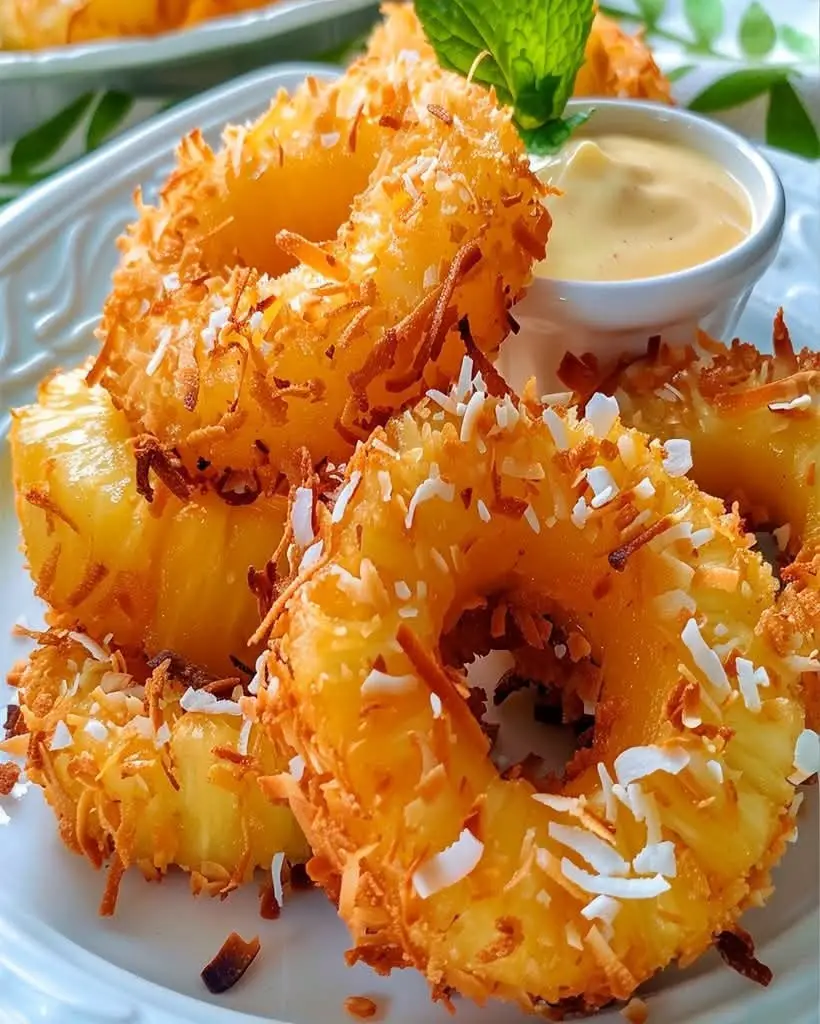Fried Pineapple with Coconut Crust: A Tropical Delight
Experience a taste sensation unlike any other with this Fried Pineapple with Coconut Crust recipe. The perfect blend of tangy and sweet, this dish offers a delightful escape to tropical flavors, all within the comfort of your own kitchen. The warm, golden crust of coconut envelops juicy pineapple, creating a dessert that’s both satisfying and nutritious. Whether you’re serving it as an inviting summer treat or looking to bring some sunshine to the cooler months, this recipe is sure to be a crowd-pleaser.
The combination of fried pineapple with a crispy coconut crust isn’t just about flavors; it’s a sensory journey that engages taste, aroma, and texture. Savory yet sweet, and delightfully light, this dish’s preparation is surprisingly simple, allowing even kitchen novices to create an impressive asset to any meal. Let’s dive into the creative world of pineapple and coconut, and explore how this dish captures the essence of island cuisine.
Quick Recipe Highlights
- Flavor Profile: Sweet and tangy with a hint of caramelization from the frying process.
- Texture: Crunchy from the coconut crust, yet tender on the inside with juicy pineapple chunks.
- Aroma: The enticing scent of toasted coconut mixed with sweet pineapple wafts through the kitchen.
- Visual Appeal: A lovely golden-brown crust with the vibrant yellow of pineapple peeking through.
- Skill Level Needed: Suitable for beginners; no special cooking skills required aside from basic frying.
- Special Equipment: A non-stick skillet or frying pan is essential to obtain the perfect crust.
Recipe Overview
- Difficulty Level: This recipe is considered easy due to straightforward preparation steps and minimal ingredients.
- Category: Ideal as a dessert or a sweet snack, bridging the gap between meals with a hint of the Caribbean.
- Cuisine: Deeply rooted in tropical culinary traditions, reminiscent of Hawaiian and Polynesian influences.
- Cost: Very budget-friendly; uses minimal, readily available ingredients with a touch of exotic flair.
- Season: Ideal for summer and spring, capturing the essence of sunny climates, but perfect whenever pineapples are in season.
- Occasion: Perfect for casual brunches, family gatherings, or whenever you crave an exotic treat.
Why You’ll Love This Recipe
The taste and texture of fried pineapple with coconut crust are irresistible. The natural sweetness of the pineapple, combined with the crispy coconut shell, offers a wonderful contrast that leaves you craving more. It hits just the right balance of savory and sweet, perfect for an indulgent dessert or a delectable snack.
Preparation is easy and convenient, with minimal prep time and uncomplicated steps that result in maximum flavor. Whether you’re an experienced cook or a beginner, anyone can whip up this satisfying dish quickly. Plus, it’s a fantastic way to incorporate fruit into your diet without compromising on the enjoyment of a luscious treat.
Nutritionally, pineapple brings plenty of vitamins and minerals, especially vitamin C and manganese, while coconut adds healthy fats and fiber. Together, they provide a drink of energy and health benefits in every bite.
The dish is excellent for social gatherings and entertaining, providing an exotic touch to your dessert offering. It’s an impressive choice for impressing guests without the stress of complicated preparations. The vibrant colors and enticing aroma will draw everyone to the table.
In terms of cost-effectiveness, both pineapple and coconut are reasonably priced, providing a lot of flavor and nutrition without breaking the bank. This accessibility makes it a go-to recipe for any occasion requiring a touch of the tropics.
Historical Background and Cultural Significance
Pineapple has a rich history that dates back to the indigenous cultures of South America, where it was revered as a symbol of hospitality and friendship. With its sweet, juicy flesh, it quickly became a cherished delicacy across various cultures, making its way to Europe and the Pacific Islands during the age of exploration.
Coconut, on the other hand, has been a staple in tropical cuisines for centuries, providing essential nutrients and versatility in culinary applications. Across Asia, Africa, and the Americas, coconut plays a crucial role in both sweet and savory dishes, being a vital ingredient in regional delicacies.
The combination of pineapple and coconut in a fried dessert is a testament to the global influence of these ingredients. This recipe embodies the spirit of island life, where tropical fruits are abundant and bursting with flavor. Over time, the popularity of such tropical combinations has led to countless adaptations, each with its own unique twist.
Regional variations of the fried pineapple with coconut crust exist across the tropics. While some regions may add a hint of spice, such as jalapeños or cinnamon, others stick to the basic recipe, allowing the natural sweetness of the ingredients to shine through. Regardless of the version, the dish remains a beloved symbol of tropical indulgence.
Ingredient Deep Dive
Pineapple has long been a symbol of warmth and hospitality in many cultures. Used in both savory and sweet recipes, its rich history is reflected in its popularity worldwide. Nutritionally, pineapple is an excellent source of vitamin C and antioxidants, ideal for boosting the immune system. When selecting pineapple, look for a firm, plump fruit with a sweet aroma. Store whole pineapples at room temperature, and once cut, refrigerate them to extend their freshness. If a fresh pineapple isn’t available, use canned or frozen as a convenient substitution.
Coconut, revered for its versatility in various cuisines, plays an essential role in the culinary world. It is a fantastic source of healthy fats, dietary fiber, and essential nutrients such as manganese. When shopping for coconut products, fresh or unsweetened shredded coconut provides the best flavor and texture. Store in airtight containers to preserve freshness. In a pinch, substitute with desiccated coconut, although the texture may differ slightly.
Common Mistakes to Avoid
- Neglecting to pat dry the pineapple slices can result in a soggy crust. Ensure excess moisture is removed for a crisp finish.
- Overcrowding the frying pan can lower the oil temperature, leading to uneven cooking. Fry in batches if necessary.
- Using old or stale coconut will result in a lackluster crust. For best results, use fresh or well-stored coconut.
- Ignoring the aromatic signals. Remove from pan when the coconut turns golden brown to prevent burning.
- Skipping the step of oil preheating. Properly preheated oil is essential for an even, golden crust.
- Failing to coat the pineapple completely. Ensure the fruit is uniformly covered for a consistent texture.
- Not monitoring the heat level can lead to deep frying. Keep the heat on medium to avoid burning the crust.
- Leaving the slices too thick or thin can affect cooking time. Aim for uniform thickness for even results.
- Serving immediately after frying without draining can result in greasy pineapple slices.
- Underestimating the frying time. A little patience is required to achieve perfect caramelization.
Essential Techniques
Proper breading technique is essential for achieving the ideal coconut crust in this recipe. Start by ensuring that the pineapple slices are dry before applying the coating. This prevents the coconut from slipping off during frying. Mastering the art of pan-frying is simple but requires attention to detail. Use a nonstick or seasoned cast iron skillet and maintain an even medium heat. Visual cues such as a golden-brown crust and audible sizzle guide you to success.
Pro Tips for Perfect Fried Pineapple with Coconut Crust
Choose ripe pineapples for the best flavor; they add natural sweetness to complement the coconut. Freeze the breaded pineapple slices briefly to help the coating adhere well. Experiment with the oil used for frying; coconut oil enhances the tropical flavor of the dish. Adding a small pinch of salt to the coconut mixture can enhance the sweetness of the pineapple. Keep a watchful eye on the stovetop to prevent the coconut from burning. Be gentle when flipping the pineapple slices to maintain integrity and presentation. Draining on paper towels after frying removes excess oil and ensures a crispy crust.
Variations and Adaptations
Regional variations abound with this recipe. In Southeast Asia, chili powder or lime zest is sometimes added for a spicy tang. Seasonal adaptations appear frequently, with peaches or mangoes being substituted for pineapple when available. Dietary modifications include gluten-free versions using coconut flour, providing options for those with gluten sensitivities. For a richer taste, incorporate cocoa powder into the coconut mixture for a chocolatey twist. Texture modifications are possible by adding crushed nuts to the coconut mixture for added crunch. Presentation alternatives like skewering the fried slices create a trendy appetizer or entertaining snack.
Serving and Presentation Guide
Serve the fried pineapple with coconut crust on a striking platter, garnished with fresh mint leaves to enhance its tropical vibe. Traditional accompaniments like a dollop of fresh whipped cream or vanilla ice cream add richness to the dish. For a modern twist, a drizzle of honey or dark chocolate lends a sophisticated edge. Consider temperature when serving; slightly warm is ideal for a mouth-melting experience. For portion control, cut the pineapple rings into wedges to make serving easier.
Wine and Beverage Pairing
Pair this dish with a chilled Sauvignon Blanc or a light Riesling; their acidity accentuates the sweetness. Non-alcoholic alternatives such as a tropical fruit punch or iced tea complement the flavor profile. If enjoying with coffee, a bold espresso or a light roast pairs beautifully. Ensure beverages are served cold or over ice to maintain the refreshing nature of the pineapple dessert. Presentation in clear glasses showcases the beverage, allowing guests to appreciate the pairing fully.
Storage and Shelf Life
Store leftover fried pineapple with coconut crust in an airtight container within the refrigerator for up to 2 days. Avoid stacking the slices, as this may cause sogginess. Signs of spoilage include off-smell and mold. To reheat, use an oven or toaster oven to retain crispness. Freezing is not recommended, as it may affect the texture and moisture content of the dish.
Make Ahead Strategies
Prepare components in advance, such as peeling and slicing the pineapple, to streamline assembly. Store prepared components separately in containers. Quality is maintained best when served fresh; re-crisping in the oven can bring back some texture to make-ahead versions. Garnishing should be done just before serving for maximum effect.
Scaling Instructions
For a smaller serving, simply halve the ingredients while maintaining the same frying method. Doubling or tripling the recipe involves frying in batches and using a larger skillet if available. Timing remains consistent, but ensure oil temperatures recover between batches for uniform cooking. Store leftovers as individually wrapped slices to minimize moisture buildup.
Nutritional Deep Dive
This recipe provides a good balance of macronutrients, with carbohydrates from the pineapple and healthy fats from the coconut. Pineapple is a low-calorie fruit rich in micronutrients such as vitamin C and manganese. Coconut adds dietary fiber essential for digestion. Consider smaller portion sizes for those managing calorie intake while still enjoying indulgence. As part of a balanced diet, this sweet treat can fit into various nutritional goals, from boosting fruit intake to satisfying sweet cravings.
Dietary Adaptations
For a gluten-free version, replace wheat flour with gluten-free all-purpose flour. Dairy-free individuals can easily enjoy this dish without additional alterations, while vegans might replace traditional frying oils with plant-based oils. To adapt for a low-carb diet, use almond flour or coconut flour in the breading. Keto dieters can incorporate unsweetened coconut flakes to maintain dietary preferences. Adapting for low-FODMAP is as simple as consuming appropriate portion sizes or using suggested lactose-free accompaniments.
Troubleshooting Guide
If the texture seems soggy, ensure the pineapple is properly drained before breading. A lack of flavor balance can be corrected by adjusting the sweetness of coconut flakes or adding a touch of salt. Temperature problems arise when pineapple is overcrowded in the pan, leading to uneven cooking. Ensure equipment like pans are of good quality to promote even heat distribution. Ingredient substitutions like alternative flours can impact the consistency of the crust—choose substitutes wisely to preserve the intended taste and texture.
Recipe Success Stories
Feedback from the community praises the aroma and simplicity of the recipe. Variations like adding cinnamon have been successful, but the core flavors remain unchanged. Readers suggest serving with a side of chilled fruit salad to enhance the tropical theme. Photographing the golden, crispy crust against vibrant pineapple is a favorite among enthusiasts for its visual appeal. The ease of the recipe encourages frequent adaptations, demonstrating its flexibility across occasions and preferences.
Frequently Asked Questions
Yes, just make sure to drain it thoroughly to remove excess juice. Canned pineapple does not affect the flavor significantly.
Is it possible to bake instead of fry?
Baking is an option if you want a healthier twist; however, the texture might be slightly less crisp than frying.
How do I prevent the coconut from burning?
Keep an eye on the heat level and flip the pineapple pieces as soon as the coconut begins to brown for even cooking.
Can I store the leftovers?
Yes, refrigeration is recommended in an airtight container. Avoid stacking to maintain the crust’s crunch.
What type of coconut is best?
Unsweetened shredded coconut is recommended for this recipe, as it provides the best texture for frying.
Is this recipe adaptable for other fruits?
Certainly! Mango and banana are excellent alternatives, bringing their own unique flavors to the mix.
What should I serve with fried pineapple?
Serve with vanilla ice cream, whipped cream, or as a topping for waffles or pancakes for a delightful twist.
Can I use different oils for frying?
Yes, coconut oil is a popular choice for intensifying the tropical flavors, but other neutral oils work well too.
Is there a vegan version?
This dish is inherently vegan-friendly if using plant-based oils for frying.
Why is my pineapple not browning?
Ensure your pan is hot enough before adding the pineapple to achieve the perfect golden crust.
Additional Resources
Explore related recipes like Coconut Shrimp or Pineapple Upside-Down Cake to expand your tropical culinary repertoire. Technique guides covering frying tips and breading processes can enhance your skill set, providing confidence for experimentation. Ingredient information about pineapple and coconut will deepen your understanding of their nutritional and culinary benefits. Equipment recommendations for nonstick and cast iron pans aid in perfecting the frying method. Seasonal variations highlight the versatility of tropical flavors, inspiring dishes across various culinary traditions.
Print
Fried Pineapple with Coconut Crust
Description
A tropical dessert featuring sweet pineapple slices fried to perfection with a crispy coconut crust.
Ingredients
For the Crust:
- 1 ripe pineapple, peeled and cored
- 1 cup shredded coconut
- 1/2 cup all-purpose flour
- 2 eggs, beaten
- 1/4 cup sugar
Instructions
1. Prepare the Crust:
- Slice the pineapple into rings about 1/2 inch thick.
- In a shallow dish, mix the shredded coconut and sugar. Place the flour and beaten eggs in separate shallow dishes.
- Dredge each pineapple ring in flour, dip in beaten eggs, and coat with the coconut mixture. Fry the coated pineapple rings in a skillet over medium heat until golden brown on each side.
Notes
You can customize the seasonings to taste.




